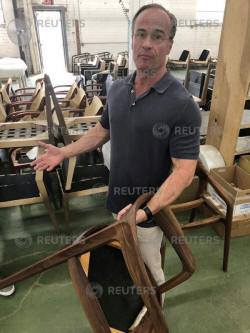In a U.S. manufacturing hub, no illusions about tariffs
and jobs
 Send a link to a friend
Send a link to a friend
 [September 26, 2018]
By Howard Schneider [September 26, 2018]
By Howard Schneider
THOMASVILLE, N.C. (Reuters) - In a town
where a 30-feet tall chair is the chief landmark, and which is
synonymous with a U.S. furniture industry decimated over the years by
imports from China, many greet the possibility of tariffs on Chinese
goods with a shrug.
No wonder. Of three once bustling Thomasville furniture plants in the
city limits, one is being demolished and cleared for parkland, another
may become the site of a new police station, and a third is being
converted into apartments.
President Donald Trump is threatening to levy tariffs of up to 25
percent on $500 billion of goods imported from China each year,
including roughly $20 billion of furniture, as a way to bring back
hundreds of thousands of manufacturing jobs lost to China and other
low-cost competitors.
Yet, the transformation of U.S. industries since China’s emergence as
the world’s low-cost producer almost two decades ago means many no
longer directly compete with Chinese imports, so tariffs may not
translate so easily into more U.S. jobs.
At family-owned Bernhardt Furniture in Lenoir, some 90 miles west of
Thomasville, executives say it would take about $30 million in capital
investment - some 10 percent of annual sales - to resurrect standard
wood furniture lines now mainly made in countries like China and
Vietnam.
That is too much to commit based on a policy that a future
administration could reverse.

"The theory is you turn (imports) off, the jobs come back. That's not
really true... The buildings don't exist. The people don't exist. The
machinery does not exist," to make the sorts of furniture that now gets
imported, said Alex Bernhardt Jr., chief executive and the company
founder's great grandson.
What the company needs now, executives say, is the open markets and
steady economy that have allowed it to grow its workforce from below 800
at the end of the 2007-2009 recession to almost 1,500 today - partly on
the basis of exports to China.
DIFFERENT COMPANY
That growth has been largely driven by demand for more customized,
higher end furniture. In expanding, the 129-year-old company has been
hiring not only factory workers, but also designers, marketing experts
and other professionals. In all, it is a different firm from what it was
three decades ago when it first began dividing product lines between the
United States and Asia.
Economists say the same is true across much of U.S. manufacturing. To
invest and hire more workers, executives would need certainty, for
example, that consumers would prefer U.S.-made products at a potentially
higher price. They would need confidence that tariffs would last beyond
the Trump administration and that production could not be shifted to
other more cost-competitive countries.
Even then, there may be little incentive to go back to old product lines
for industries that have changed dramatically because of globalization.
Across the Rust Belt and the former factory towns of the south, the
transformation is apparent. In Buffalo, an old steel mill is now a solar
panel factory, and a retail goods manufacturer now houses an office and
restaurant park.
In Cleveland, a shuttered GM plant has reopened as a Chinese-owned auto
glass company. Abandoned factories throughout North Carolina have landed
on the Environmental Protection Agency's list of "brownfield" sites that
need cleanup.
Some companies are considering moving production from China as a result
of the tariffs, but the jobs are unlikely to head home.
Illinois-based CCTY Bearing, for example, said it planned to move
U.S.-bound production from Zhenjiang, China, to a new plant near Mumbai
in India to keep labor costs down.
JLab Audio's China-made Bluetooth products are not being taxed yet, but
its chief executive Win Cramer had been scouting for suppliers in
Vietnam and Mexico.
"I would love to build products onshore, but consumers have proven time
and time again that "Made in America" isn't as valuable a statement as
it once was," Cramer said. "They make decisions based on the cost."
[to top of second column] |

Alex Bernhardt, Jr., President and Chief Executive of family-owned
Bernhardt Furniture is seen at the company's plant in Lenoir, North
Carolina, U.S., August 15, 2018. REUTERS/Howard Schneider

The price of, say, its Bluetooth earbud would jump from $20 to as much as $50 if
it was made in the United States, Cramer said, far more than what tariffs would
add to the cost of imports.
To be sure, early reactions suggest that foreign companies that make U.S.-bound
goods in China may move some of that production to the United States. Still,
countries such as Vietnam may ultimately benefit the most from Trump's tariffs.
Japanese construction and mining equipment maker Komatsu Ltd < 6301.T > has said
it has already shifted some of its production of parts for U.S.-built excavators
from China. Part of that production moved to the United States, but some also
went to Mexico and Japan.
In South Korea, LG Electronics <066570.KS> and its rival Samsung Electronics
<005930.KS> are considering moving parts of U.S.-bound refrigerator and air
conditioner production to Mexico, Vietnam or back home, but not to the United
States, according to company sources and local media.
STEADY RECOVERY
The responses to Trump's tariffs on steel and aluminum show how such steps
create both winners and losers.
Producers such as U.S. Steel and Century Aluminum have said they will add at
least several hundred jobs as a result of the higher prices they can charge.
Mid-Continental Nail, however, laid off 130 workers because of those higher
steel prices, and furniture parts maker Leggett & Platt <LEG.N> has warned that
rising metal prices would prompt it to shift production abroad.
So far, Washington has imposed duties on $250 billion of Chinese imports and
Trump has threatened to slap tariffs on all Chinese goods.
Many economists project new tariffs would on balance either slow down hiring or
cause job losses in a manufacturing sector where employment has grown by 10
percent over the past eight years without special protection.(Graphic: https://tmsnrt.rs/2Q1AFUW)
The furniture industry, among the hardest hit by Chinese imports, has added
43,000 jobs since its employment hit a low of 350,000 in 2011, helped by the
recovering housing market and strong consumer demand.

Industry officials say skilled upholsterers and other workers are hard to find,
echoing the Federal Reserve's concern about the impact of worker shortages on
the U.S. economy.
In Thomasville, few expect that tariffs will bring furniture manufacturing back
to its heyday, nor does the community need it, says city manager Kelly Craver,
whose parents worked in the furniture and textile industries.
Since the recession, Thomasville has become a residential hub for growing nearby
cities such as Greensboro and Charlotte. It also has its own mix of
manufacturing and white collar jobs. Mohawk Industries <MHK.N> recently expanded
its Thomasville laminate flooring facility while the Old Dominion Freight Line
transportation firm <ODFL.O> and the fast-growing Cook Out burger chain have
corporate headquarters there.
"We, for the very first time in this city's existence, are going to have a
diversified economy," Craver said.
(Additional reporting by Rajesh Kumar Singh in CHICAGO; Jess May Yu in TAIPEI,
Makiko Yamazaki in TOKYO and Ju-min Park and Heekyong Yang in SEOUL; Editing by
David Chance and Tomasz Janowski)
[© 2018 Thomson Reuters. All rights
reserved.] Copyright 2018 Reuters. All rights reserved. This material may not be published,
broadcast, rewritten or redistributed.
Thompson Reuters is solely responsible for this content. |